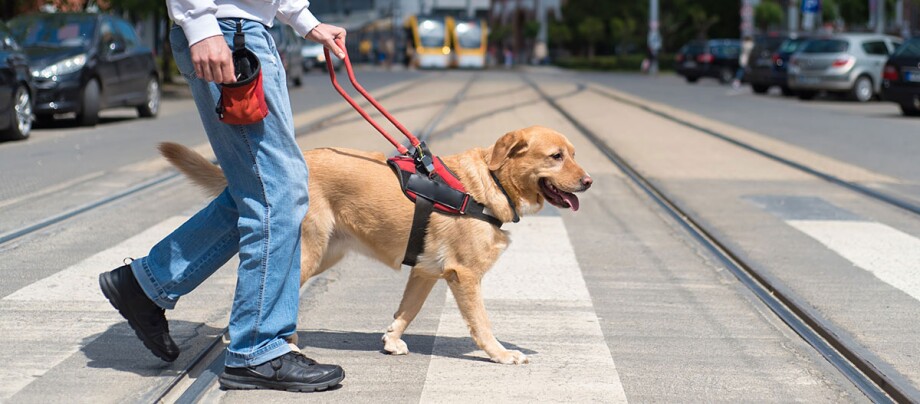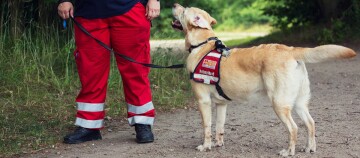Companion Dog Test - to Pass, Certain Requirements Have to Be Met
07.10.2022 - Reading time: 5 minutes

The companion dog test, abbreviated in German as BH, is a state-recognised test to determine the character of a dog. Not every dog and dog owner need to take it. Basically, all dogs that work closely with people are tested. This includes, for example, assistance dogs or police and rescue service dogs. To pass the companion dog test, certain requirements have to be met.
The companion dog test is a test of a dog’s character and behaviour recognised by the German government. It is taken jointly by the dog and the dog owner/handler, who act as a team in the main part of the test. The companion dog test assesses the dog’s behaviour with strangers, its behaviour in public and its ability to obey commands. It is important to find out how the dog reacts in stressful situations, for example how it behaves towards joggers and cyclists, loud or boisterous people. You can only take the companion dog test in FCI clubs (Fédération Cynologique Internationale) such as the VDH, the German Canine Association.
The so-called competency certificate does not strictly count towards the companionship certificate, however, without it you won’t get far. For this test you have to prove your knowledge. The questions you are asked before the companion certificate test relate to basic knowledge about dogs and their behaviour in general. By answering the answers correctly, you can show that you are capable of training and managing a dog, as well as able to correctly judge their behaviour patterns and how to deal with them. The competency certificate in Germany is a written theory test made up of a series of multiple-choice questions in which you have to choose the right answer from amongst a selection of wrong answers.
As a rule, only dogs who are older than 15 months old are allowed to have a companionship certificate.
Other prerequisites include:
- your membership of a canine association recognised by the FCI [Fédération Cynologique Internationale]
- a completed competency certificate (see above)
- your dog’s identification
The last part is checked as part of the companion certificate by using your dog’s chip or tattoo number and comparing it to their passport, which it must match. The companion certificate test itself has a set procedure which is made up of three parts. They are carried out at a training ground as well as in public. If at any point during the test your dog shows a lack of knowledge on what’s being tested, they will not pass.
The first part of the test is actually a personality test for your dog, also known as a nature test. A trainer or examiner will test how your dog behaves towards other people and dogs. If they are particularly frightened or aggressive then they will not pass the test as a whole.
The subordination/obedience part is the second part of the test and is at the heart of the companionship certificate test. Across a wide range of tests, your dog’s obedience will be judged. The focus of the test is to see if your dog follows commands and how you work together as a team.
The following will be tested:
- Lead training/walking to heel: when running, at a normal walking pace and when turning, both on and off the lead
- Sitting from running, both on and off the lead
- Coming to heel and lying down
- Lying down whilst distracted by another human and dog team
- Going through groups of people both on and off the lead
The tests will be carried out with changes of pace, stops and changes of directions. At all times your dog should stay focussed on you and attentive, and leave other humans and dogs alone or act uninterested in them.
In order to pass this part of the test, your team must get 70% of the possible 60 points available in order to continue with the companion certificate.
After passing the obedience test, your team will go to the final round which takes place outside of the training centre. The final test is to be undertaken at popular public places such as train stations, car parks and parks, etc.
As in the first part of the test, your dog’s knowledge will be judged, only this time it is under real-world conditions. For this, the exercises you carried out in the second part are repeated but as they would occur on a day-to-day basis. How does your dog react when they go past screaming, annoying children or a rude group of cyclists? Can you easily let your dog loose when unknown people go by? These and other exercises make up the hardest part of the test.
All of the tasks in this final part of the test are used by an examiner to assess your dog’s nature, knowledge and behaviour. As in other parts of the test, your dog should not pull on the lead, nor be pulled or shouted at by you.
Once you have successfully finished this part of the test, you and your four-legged friend have done it! The examiner will explain the results to you at the end and you will get written confirmation that you have passed the companion certificate test.
All dog owners need a companion certificate test if they want their dog to take part in any of the following events or trainings:
- Competitive canine sports (e.g. agility, obedience)
- Trail work
- Scent tracking
- Further dog certificates/training
Those who want to use their dog to work with people must have a companion certificate. All dog-human teams working in the public sector are included in this, such as police and rescue teams. Also those who want to use their dogs for therapy or as assistance dogs in care homes need the certificate. When helping the sick or people with emotional and/or physical disabilities, therapy and assistance dogs are working hard. For this job, they have to have an absolutely reliable personality – they must be open to strangers, trusty and playful. Trained assistance dogs may also be needed to take on responsibility for the person “entrusted” to them, which means they will need to be trained accordingly.
VITA assistance dogs from the non-profit organisation Vita e.V. show why a knowledge test is important.


